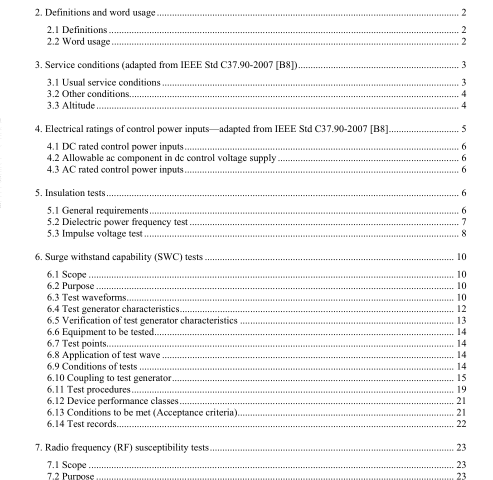IEEE 1613-2009 pdf download.IEEE Standard Environmental and Testing Requirements for Communications Networking Devices Installed in Electric Power Substations.
3. Service conditions (adapted from IEEE Std C37.90-2007 [B8]) Service conditions include operational and nonoperational temperature, and relative humidity. Conditions outside the scope of this standard are listed in 3.2.
3.1 Usual service conditions
Communications networking devices conforming to this standard shall be suitable for operation under the following conditions outlined in 3.1.1 through 3.1.3, 3.2, and 3.3.
3.1.1 Operational temperature range
Operational temperature is the temperature of still air measured 30 cm from the surface of the unit (communications networking device) enclosure while in operation and with communications profile 3, as defined in Table 8 and Table 9. For a specified temperature range (for example, –20 °C to +55 °C), a unit shall be able to start up and continue its operation at the specified minimum temperature (i.e., –20 °C) within 5 min after having been deenergized for a sufficient time such that its internal components have cooled to that temperature without condensation. A unit shall also be able to start up and continue its operation within 5 min at the specified maximum temperature (i.e., +55 °C) after having been deenergized for a sufficient time such that its internal components have heated to that temperature. If the unit to be tested is modular, then the configuration to be tested shall be the maximum heat-generating configuration permitted by the manufacturer and include dual power supplies if such a design option is available.
The manufacturer shall declare one of the following ranges of ambient temperature for which the unit is to be rated:
a) –40 °C to +70 °C
b) –30 °C to +65 °C
c) –20 °C to +55 °C (the default range if no other range is specified)
d) Range defined by the manufacturer, but in no event shall the low temperature be higher than –20 °C nor the high temperature be lower than +55 °C
3.1.2 Nonoperational temperature range
Nonoperational temperature is the air temperature for conditions of transport, storage, and installation, such that the unit will not experience damage due to indefinite exposure to such temperatures.
The manufacturer shall declare one of the following ranges of ambient temperature for which the unit is to be rated:
a) –50 °C to +85 °C
b) –40 °C to +75 °C
c) –30 °C to +65 °C (the default temperature range if no other range is specified)
d) Range defined by the manufacturer, but must encompass –30 °C to +65 °C
3.1.3 Relative humidity
Communications networking devices shall be capable of withstanding an average relative humidity up to 55% outside of the device or communication networking system’s enclosure or cover for a temperature within the defined operational and nonoperational ranges, with excursions up to 95% without internal condensation for a maximum of 96 h.
3.2 Other conditions
Other conditions not covered by this standard may require special construction, treatment, or operational considerations. These shall be brought to the attention of those responsible for the application, manufacture, and operation of communications networking devices. Among such conditions is exposure to the following:
a) Damaging smoke, fumes, or vapors.
b) Moisture or dripping water.
c) Dust (abrasive, magnetic, conductive, obstructive, etc.).
d) Explosive mixtures of dust and gases.
e) Steam.
f) Salt air.
g) Seismic disturbances.
h) Transportation or storage conditions.
i) Extreme temperature or sudden change in temperature.
j) Extreme variations of supply voltage.
k) Excessive electrical wave distortion.
l) Excessive electrical noise.
m) Electromagnetic radiation other than that specified in Clause 8. See CISPR 24-1997 [B1] for methods to mitigate broadband radio frequency (RF) noise from substation corona discharges.
n) Nuclear radiation.
3.3 Altitude
3.3.1 Usual altitude
The usual condition of altitude shall be 1500 m or less.
3.3.2 Derating for altitude
The dielectric strength and the cooling effects of air insulation are affected by the decrease in relative air density at higher altitudes. Therefore, the insulation and temperature ratings of communications networking devices tested and/or applied at higher altitudes shall be derated according to the information given in 3.3.2.1 and 3.3.2.2.IEEE 1613 pdf download.IEEE 1613-2009 pdf download
IEEE 1613-2009 pdf download

Leave a Reply